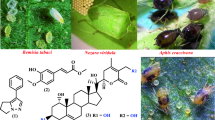Abstract
The isolation fraction 8 of petroleum ether extract of Pharbitis purpurea (P. purpurea) seeds was identified and its action mechanism against Tetranychus cinnabarinus (T. cinnabarinus) was initially investigated. Thin-layer chromatography (TLC) was used to measure purity of the isolation fraction 8. Ultraviolet (UV) and infra-red (IR) spectrum, nuclear magnetic resonance (NMR), gas chromatography and mass spectrum (GC-MS) were used to identify the main component of the isolation fraction 8. The influence of several kinds of enzyme activity such as glutathione-S-transferase (GSTs), acetylcholine esterase (AChE), mono-amine oxidase (MAO) and ATPase in body of T. cinnabarinus was tested with the biochemical method. Results showed that the isolation fraction 8 was the methyl linoleate. The methyl linoleate could activate GSTs in T. cinnabarinus. The isolation fraction 8 had strong toxic effect on T. cinnabarinus because it could inhibit in various degrees AChE, MAO and ATPase related to nervous system, which might lead to blocking neurotransmission and the death of mites. So, P. purpurea seeds have better development prospects that the methyl linoleate is regarded as new pesticide.
Access this chapter
Tax calculation will be finalised at checkout
Purchases are for personal use only
Preview
Unable to display preview. Download preview PDF.
Similar content being viewed by others
References
Hazan, A., Gerson, U., Tahori, A.S.: Spider mite webbing I. The production of webbing under various environmental conditions. Acarologia 16, 68–84 (1974)
He, L., Yang, Y., Fu, J.Z., et al.: Resistance selection and relative fitness of Tetranychus cinnabarinus (Boisduval)to abamectin. Acta Phytophylacica Sinica 31, 395–400 (2004)
Ho, C.C., Lo, C.C., Chen, W.H.: Spider mite (Acari:Tetranychidae) on various crops in Taiwan. J. Agr. Res. China 46, 333–346 (1997)
Tang, C.C., Li, Y.X., Chen, B., et al.: Pesticide chemistry, vol. 3, p. 225. Nankai University Press (1998)
Wang, X., Gao, X.W., Zheng, B.Z.: Investigation on insecticide resistance of diamondback moth. World Agriculture 223, 27–29 (1997)
Zhao, S.H.: Chemoproection of plant, vol. 1, p. 303. China Agriculture Press (2001)
Wang, Y.N., Miao, P.F., Cao, H., et al.: Effect of Extracts of Leaves of Juglans regia to Several Enzyme Systems in Tetranychus cinnabarinus. Acta Horticulturae Sinica 34, 1297–1300 (2007)
Cao, H., Wang, Y.N., Liu, S.Q., et al.: Effect of Extracts of Kochia scoparia to Several Enzyme Systems in Tetranychus viennensis. Scientia Silvae Sinicae 43, 68–72 (2007)
Shi, G.L., Wang, Y.N., Wang, H.L., et al.: Effect of Tagetes erecta on glutathiong-S-transferase and protease activities and protein content in Tetranychus viennensis. Chinese Journal of Applied Ecology 183, 400–404 (2007)
Wang, H.X., Shen, Z.J., Du, J., et al.: Insecticidal Activity of Juglans regia Extracts against Tetranychus cinnabarinus. Scientia Silvae Sinicae 44, 16–20 (2008)
Dong, Y.X., Wu, W.J.: Research progress of plant insecticide toxicology. Entomological Knowledge 34, 112–116 (1997)
Ren, X.X., Han, Z.J., Wang, Y.C.: Cloning and sequence analysis of a DNA fragment encoding acetylcholinesterase in cotton bollworm. Acta Zoologica Sinica 48, 121–124 (2002)
Mu, L.Y.: Plant chemical protection. China Agriculture Press (1991)
He, Y.X., Wang, C.F., Chen, F., et al.: Effect of insecticides on esterase activity in beet armyworm. Acta Agriculture Universitis Jiangxiensis 25, 896–899 (2003)
Liu, S.Y., Sun, L.G., Xing, W., et al.: The effect of chronic lead exposure on hippocampal intraneuronal Ca2 + and activity of Ca2 + -ATPase in rats. Journal of Health Toxicology 13, 16–17 (1999)
Mark, A., Dekeyser, R.G.H.: Downer Biochemical and Physiological Targets for Miticides Pestic. Sci. 40, 85–101 (1994)
Wang, M.C.: Entomological Physiology, pp. 202–203. China Agriculture Press (2004)
Author information
Authors and Affiliations
Editor information
Editors and Affiliations
Rights and permissions
Copyright information
© 2012 Springer-Verlag GmbH Berlin Heidelberg
About this chapter
Cite this chapter
Du, J. et al. (2012). A Preliminary Study on Activity Mechanism and Identification of an Extract of Pharbitis Purpurea Seeds against Tetranychus Cinnabarinus. In: Zhu, E., Sambath, S. (eds) Information Technology and Agricultural Engineering. Advances in Intelligent and Soft Computing, vol 134. Springer, Berlin, Heidelberg. https://doi.org/10.1007/978-3-642-27537-1_69
Download citation
DOI: https://doi.org/10.1007/978-3-642-27537-1_69
Publisher Name: Springer, Berlin, Heidelberg
Print ISBN: 978-3-642-27536-4
Online ISBN: 978-3-642-27537-1
eBook Packages: EngineeringEngineering (R0)




